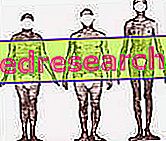The Heart: Outline of Anatomy and Physiology
The heart is a muscle with an average weight of about 350 g in humans and 300 g. in the woman. It is located in the center of the chest with the tip or apex directed forward and to the left.
It consists of 4 cavities (or chambers), 2 atria and 2 ventricles, respectively atrium and right ventricle, atrium and left ventricle. Right atrium and right ventricle and left atrium and left ventricle are separated from each other by two atrioventricular valves, respectively (tricuspid on the right and bicuspid on the left), The two atria are separated from each other by the interatrial septum while the two ventricles are separated by the interventricular septum. The atria form the upper part of the heart and are made up of thinner muscle tissue than the ventricles, which make up most of the organ.
The heart functions like a pump, receives blood from the periphery, and first introduces it into the lungs and then back into the large circle.
The passage through the lungs has the purpose of purifying the blood from carbon dioxide and enriching it with oxygen.
The heart, like all other muscles, needs oxygen and nutrients supplied by the coronary arteries.
Physiological adaptations of the heart in response to physical activity
Adaptations of the heart in response to physical activity depend on the type of sport practiced. In particular, for all background activities (running, walking, cycling, cross-country skiing, etc.) the heart gradually adapts to increase the volume of its cavities. An increase in cardiac cavities allows the heart to produce greater systolic range (the amount of blood leaving the left ventricle at the end of each systole), thus increasing the amount of blood available to the tissues.
As for static sports such as weight lifting or bodybuilding, the heart adapts by increasing the thickness of the myocardial walls. During these sports, in fact, the massive contraction of large muscular masses causes the partial occlusion of the blood vessels, which leads to an increase in pressure and a greater work of pressure from the heart. This sharp increase in pressure is potentially very dangerous for heart patients, hypertensives and diabetics but can be limited by adopting a correct breathing technique.
| Dynamic exercise | Static exercise |
| Increase in heart rate proportional to metabolic demands | Less increase in heart rate |
| Little or no increase in mean arterial pressure | Marked increase in average arterial pressure |
| Prevalent vasodilation | Prevalent vasoconstriction |
| Facilitated venous return | Obstructed venous return |
| Increased myocardial oxygen consumption | Increased myocardial myocardial oxygen consumption |
| Proportional increase in stroke volume and cardiac output | Increase in inadequate systolic range and cardiac output |
HEART VOLUME WORK | HEART PRESSURE WORK |



